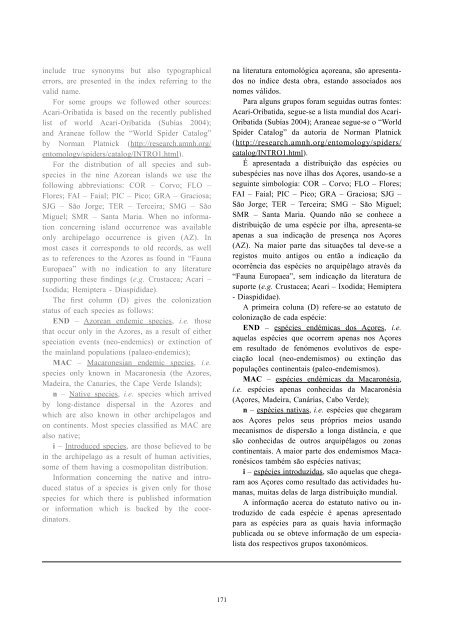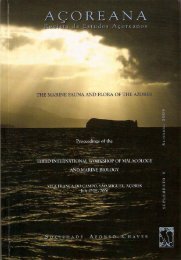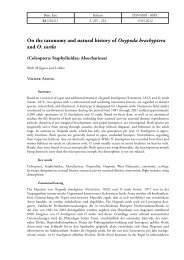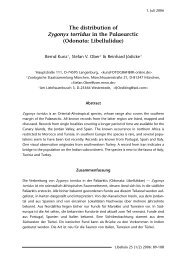(eds.) (2005). - Portal da Biodiversidade dos Açores - Universidade ...
(eds.) (2005). - Portal da Biodiversidade dos Açores - Universidade ...
(eds.) (2005). - Portal da Biodiversidade dos Açores - Universidade ...
Create successful ePaper yourself
Turn your PDF publications into a flip-book with our unique Google optimized e-Paper software.
include true synonyms but also typographical<br />
errors, are presented in the index referring to the<br />
valid name.<br />
For some groups we followed other sources:<br />
Acari-Oribati<strong>da</strong> is based on the recently published<br />
list of world Acari-Oribati<strong>da</strong> (Subías 2004);<br />
and Araneae follow the “World Spider Catalog”<br />
by Norman Platnick (http://research.amnh.org/<br />
entomology/spiders/catalog/INTRO1.html).<br />
For the distribution of all species and subspecies<br />
in the nine Azorean islands we use the<br />
following abbreviations: COR – Corvo; FLO –<br />
Flores; FAI – Faial; PIC – Pico; GRA – Graciosa;<br />
SJG – São Jorge; TER – Terceira; SMG – São<br />
Miguel; SMR – Santa Maria. When no information<br />
concerning island occurrence was available<br />
only archipelago occurrence is given (AZ). In<br />
most cases it corresponds to old records, as well<br />
as to references to the Azores as found in “Fauna<br />
Europaea” with no indication to any literature<br />
supporting these findings (e.g. Crustacea; Acari –<br />
Ixodi<strong>da</strong>; Hemiptera - Diaspidi<strong>da</strong>e).<br />
The first column (D) gives the colonization<br />
status of each species as follows:<br />
END – Azorean endemic species, i.e. those<br />
that occur only in the Azores, as a result of either<br />
speciation events (neo-endemics) or extinction of<br />
the mainland populations (palaeo-endemics);<br />
MAC – Macaronesian endemic species, i.e.<br />
species only known in Macaronesia (the Azores,<br />
Madeira, the Canaries, the Cape Verde Islands);<br />
n – Native species, i.e. species which arrived<br />
by long-distance dispersal in the Azores and<br />
which are also known in other archipelagos and<br />
on continents. Most species classified as MAC are<br />
also native;<br />
i – Introduced species, are those believed to be<br />
in the archipelago as a result of human activities,<br />
some of them having a cosmopolitan distribution.<br />
Information concerning the native and introduced<br />
status of a species is given only for those<br />
species for which there is published information<br />
or information which is backed by the coordinators.<br />
171<br />
na literatura entomológica açoreana, são apresenta<strong>dos</strong><br />
no índice desta obra, estando associa<strong>dos</strong> aos<br />
nomes váli<strong>dos</strong>.<br />
Para alguns grupos foram segui<strong>da</strong>s outras fontes:<br />
Acari-Oribati<strong>da</strong>, segue-se a lista mundial <strong>dos</strong> Acari-<br />
Oribati<strong>da</strong> (Subías 2004); Araneae segue-se o “World<br />
Spider Catalog” <strong>da</strong> autoria de Norman Platnick<br />
(http://research.amnh.org/entomology/spiders/<br />
catalog/INTRO1.html).<br />
É apresenta<strong>da</strong> a distribuição <strong>da</strong>s espécies ou<br />
subespécies nas nove ilhas <strong>dos</strong> <strong>Açores</strong>, usando-se a<br />
seguinte simbologia: COR – Corvo; FLO – Flores;<br />
FAI – Faial; PIC – Pico; GRA – Graciosa; SJG –<br />
São Jorge; TER – Terceira; SMG – São Miguel;<br />
SMR – Santa Maria. Quando não se conhece a<br />
distribuição de uma espécie por ilha, apresenta-se<br />
apenas a sua indicação de presença nos <strong>Açores</strong><br />
(AZ). Na maior parte <strong>da</strong>s situações tal deve-se a<br />
registos muito antigos ou então a indicação <strong>da</strong><br />
ocorrência <strong>da</strong>s espécies no arquipélago através <strong>da</strong><br />
“Fauna Europaea”, sem indicação <strong>da</strong> literatura de<br />
suporte (e.g. Crustacea; Acari – Ixodi<strong>da</strong>; Hemiptera<br />
- Diaspidi<strong>da</strong>e).<br />
A primeira coluna (D) refere-se ao estatuto de<br />
colonização de ca<strong>da</strong> espécie:<br />
END – espécies endémicas <strong>dos</strong> <strong>Açores</strong>, i.e.<br />
aquelas espécies que ocorrem apenas nos <strong>Açores</strong><br />
em resultado de fenómenos evolutivos de especiação<br />
local (neo-endemismos) ou extinção <strong>da</strong>s<br />
populações continentais (paleo-endemismos).<br />
MAC – espécies endémicas <strong>da</strong> Macaronésia,<br />
i.e. espécies apenas conheci<strong>da</strong>s <strong>da</strong> Macaronésia<br />
(<strong>Açores</strong>, Madeira, Canárias, Cabo Verde);<br />
n – espécies nativas, i.e. espécies que chegaram<br />
aos <strong>Açores</strong> pelos seus próprios meios usando<br />
mecanismos de dispersão a longa distância, e que<br />
são conheci<strong>da</strong>s de outros arquipélagos ou zonas<br />
continentais. A maior parte <strong>dos</strong> endemismos Macaronésicos<br />
também são espécies nativas;<br />
i – espécies introduzi<strong>da</strong>s, são aquelas que chegaram<br />
aos <strong>Açores</strong> como resultado <strong>da</strong>s activi<strong>da</strong>des humanas,<br />
muitas delas de larga distribuição mundial.<br />
A informação acerca do estatuto nativo ou introduzido<br />
de ca<strong>da</strong> espécie é apenas apresentado<br />
para as espécies para as quais havia informação<br />
publica<strong>da</strong> ou se obteve informação de um especialista<br />
<strong>dos</strong> respectivos grupos taxonómicos.

















